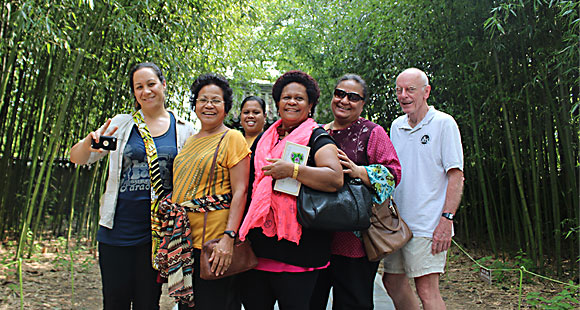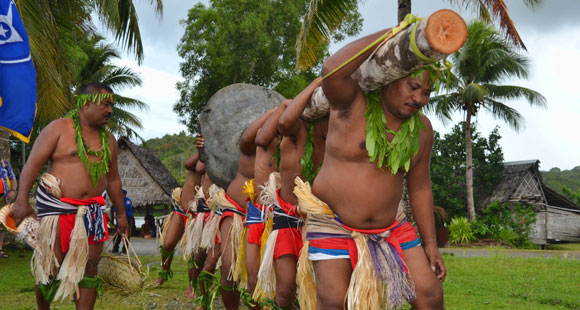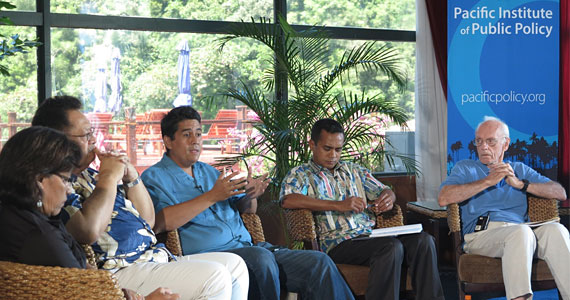Hanging on to Cultural Knowledge…Korea-Style
Korea may seem an unlikely spot for mounting a crusade aimed at cultural preservation in the Pacific, but the UNESCO Center for the Asia Pacific Region happens to be located there. So it was that a handful of us from the Pacific met there in the traditional southern town of Jeonju. Did I say town? Jeonju is really a city with beautifully designed glass and steel buildings and a population bigger than my hometown (Buffalo). But it also is the home of a traditional Korean village, the palace of the emperors of the Chosun dynasty (who first came to power in the 14th century), and the burial place of the first Christian martyr in Korea.
With its mix of ancient and modern, Jeonju is a splendid example of what UNESCO is trying to promote in the Pacific: allowing a proper place for the new and the old in a rapidly changing social landscape. So it was that ICHCAP–Intangible Cultural Heritage Center for Asia and the Pacific–brought together seven representatives from the Pacific for a three-day meeting August 19-21. The group included Tina Rehuher-Marugg and Meked Besebes from Palau, along with Una Nabobo-Baba, a Fijian woman currently teaching at the University of Guam. Pulupaki from Tonga, Apolonia from Fiji, and Lea Lani from the University of the South Pacific rounded out the group. Then there was myself, the only male and the sole haole in the contingent.
We were there to review articles written on cultural heritage as seen from a variety of its aspects by people of different Pacific islands. The articles are to be published in a book: Traditional Wisdom of the Pacific Islands. The book doesn?t pretend to encapsulate island wisdom. It?s only the first thrust in a longer campaign that will have to be carried on within the islands themselves. The articles on Micronesia include one on canoe-building on Mokil, another on navigation in the Yap Outer islands, and yet another on traditional taro cultivation in Palau. There are many others besides.
Don?t we already have articles on many of these topics? Sure, we do. But the articles are just the tip of the stingray-barbed spear, so to speak. The real purpose of ICHCAP is to celebrate, preserve and protect the intangible cultural heritage in the islands. Canoes, drums, masks and even whole meeting houses have been carted off for display in museums in Hawaii, Germany and other places. Yet, the knowledge of how to produce these cultural artifacts, and so many other items that carry so much meaning in island culture, is the proud possession of the Pacific peoples themselves. While this knowledge survives, that is. In a time of rapid change and heavy emigration, its survival is precarious.
This is true not just of technical knowledge?how to attach the outriggers to a sailing canoe and lash the joints of a meeting house, for instance?but of the wisdom enshrined in the old ways. The Western world is screaming for people around the world to adopt the ballot box to ensure that everyone?s interests are heard. But traditional Yap developed a political system based on a complicated network of villages that included everyone on the island. With the extension of this system to the chain of outer atolls, even the atoll dwellers were represented. Shouldn?t this count as valuable wisdom? Even if it is not longer functional, shouldn?t it be remembered?
So, the point of the program is to celebrate and preserve the knowledge and wisdom of the past, even if all the old sharkskin covered drums have been carted off to museums abroad. But we should not forget the final goal of the ICHCAP program?to protect this knowledge as the property of islanders, not as exotic material to be plundered simply to market Western goods or to fashion the next Disneyland village. In an age of mind-numbing legal complexity, it may be important to stamp this technical knowledge with a ?Made in the Islands? seal to ensure that rights remain with the people who created it.
But the trip wasn?t all business. On a trip to the museum on the final day, we learned how paper was made from mulberry bark in Korea. Then, in what was a first for all, each of us made our own single sheet of paper almost from scratch.
Many thanks, Dr. Samuel Lee and Dr. Seong-Yong Park and staff, for a remarkable experience.
……………….
PS. Don Evans reminds us that Yap?s next Homecoming Day, scheduled for mid-June 2015, will feature the beginning of the Manta Ray Diving operation. Plan to be there for the event.





